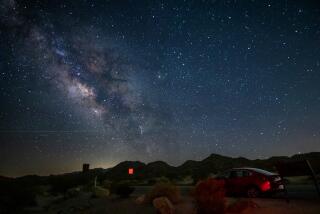LED coolness can pose a problem for traffic signals
Reporting from Chicago — Lisa Richter was making a left turn on a green light last spring when she was struck by a vehicle traveling the opposite direction, killing her instantly.
Authorities say Richter, 34, might still be alive if not for an unintended consequence of green technology: The LED traffic signal facing the other driver was obscured by snow.
“If the light had not been covered . . . the accident would have not occurred,” said Det. Rob Sherwood of the Oswego, Ill., Police Department.
Municipalities nationwide have switched to LED traffic signals because they burn brighter and save money by lasting longer and using 90% less energy than incandescent bulbs. But they also emit less heat -- meaning they sometimes have trouble melting snow.
Manufacturers have looked at solutions, such as adding a heating element to LED signals. But that would diminish the energy savings, said Roy Burton, chief executive of Dialight.
“We can remove the snow with heat, but the cost of doing that in terms of energy use has not brought any enthusiasm from cities and states that buy these signals,” Burton said. “They’d like to be able to take away this issue, but they don’t want to spend the money and lose the savings.”
Those energy savings can be significant -- up to 80%. LEDs also last up to 10 times longer than incandescent bulbs.
And cities can receive funding to cover upfront costs. The Illinois Clean Energy Community Foundation has given out $9.9 million in grants for 150 government agencies to upgrade traffic signals at nearly 5,400 intersections around the state, according to the foundation’s website.
Meanwhile, the Illinois Department of Transportation has required communities that install red-light cameras to use LED traffic lights at those intersections because they burn brighter, said Priscilla Tobias, a safety engineer for the transportation department.
LEDs “are much more visible to the motorist, so they have more time to see the traffic signal and react,” Tobias said. “Not only are we addressing energy efficiency, we’re also improving safety at intersections.”
According to traffic engineers, snow can cover LED traffic signals only under certain conditions -- wet, driving snow and freezing temperatures -- and rarely does it happen to every signal at an intersection.
The problem can be remedied by maintenance crews using brooms, engineers said, and occurs so infrequently that it does not outweigh the benefits of energy efficiency.
“Maybe it takes longer to melt and you have to go and clean them off,” said Tony Khawaja, a traffic engineer for the Lake County, Ill., Division of Transportation, “but it’s part of the trade-off for years of energy savings.”
More to Read
Sign up for Essential California
The most important California stories and recommendations in your inbox every morning.
You may occasionally receive promotional content from the Los Angeles Times.









